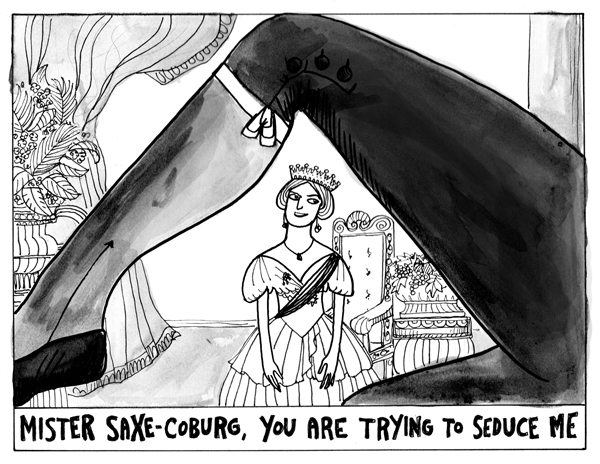June 15, 2009
Like Minds: The Triumphs and Trials of Collaboration
Well, first of all let me apologize for the prolonged suspense! This summer holiday went into several rounds of overtime, and I have been caught up in the very busy business of reading in the backyard, meeting with old friends for tea and teaching the little one which rocks, twigs and leaves at the park are best for eating (answer: any). But all good things have to come to an end, and new good things have to be taken up again.
May’s virtual exhibit, Like Minds: The Triumphs and Trials of Collaboration has been an eye opener. First of all, submissions were overwhelmingly genre books, science fiction and fantasy. Being a fan of both genres I can’t say that I mind, though as I wasn’t able myself to come up with many non-genre examples and had hoped you lot out there would be able to jog my memory. Not a lot of luck there, but it does stand out as a sort of mystery to me. Why are genre writers so willing to share a byline, while examples in “literary” fiction are impossible to come by? I don’t have an answer today.
June 2, 2009
Ah, summer holidays…
Just a quick PSA to let you know that I’m not dead, but that I won’t be making any posts this week before Friday’s Digital Book Collection. Real life… you know how it is.
So in the meantime, go out with your phones and your cameras and hunt books! The deadline for this month’s contest is Thursday night – lots of time to inundate my inbox with entries.
See you then!
May 29, 2009
Contest: The May Digital Book Collection
Welcome back, or perhaps just welcome if you’re new to this. It is the last Friday of the month, and that means community building time here at Inklings!
What’s this? For a full explanation, check out this post. Or, try to divine the gist of it from the following:
One per month Inklings hosts a virtual book collecting contest. The object will be to build, virtually, a collection on a theme of my choosing. Our collective task will be to bring together images of books that we think belong in the collection. In order to submit a book to the collection you need only take a picture of it. You don’t have to own it but you do have to be able to take a picture of it – no Googled images allowed! Go out and look around; check bookstores, libraries, garage sales, museums, friends’ houses – anywhere! If you see a book that belongs in the collection, snap a photo of it and send it in to charlotte@once-and-future.com along with a short description of the book (title, author, publication date; that kind of thing) as well as a note on where you found the book and why you think it belongs in the collection. No limit to the number of entries, either – go wild!
Next Friday I will compile all the submissions and present a virtual exhibition of our collection. The person who submits the “best” contribution will get a prize – this month I have a lovely upcycled lined journal from Cover Stories on the offer. Please have your entries to me by bedtime on Thursday, June 4th 2009.
Need some inspiration? Check out our past exhibits:
Travel: The Poetry of Motion (April)
Diversions, Distractions and Diabolical Deeds: Entertainments for a Darkened Room (March)
This month’s theme is Like Minds: The Triumphs and Trials of Collaboration. I have to say that collaboration is something I have a weakness for, as I am almost always convinced that the marriage of two artists I love can only result in a product twice as good as either could have produced independently. Of course, history has proven me horribly wrong (Dancing in the Street *coff*) – but epic failures always make the best collectibles! In any case, here are a few ideas:
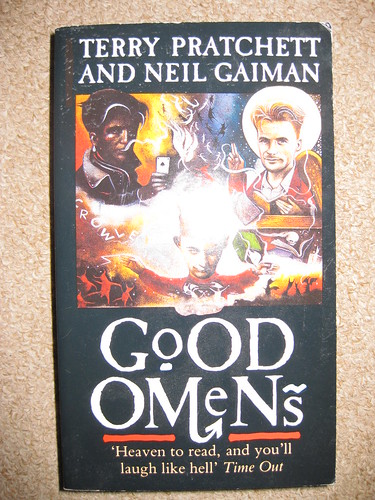
What? Good Omens by Terry Pratchett & Neil Gaiman, Corgi, 1991
Where? On my husband’s bookshelf.
Why? This is an utterly uncollectible edition, but the work itself is one of the best collaborations in speculative fiction. One of the cases where two heads really are better than one!
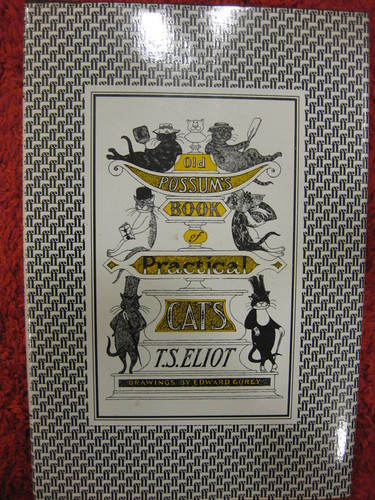
What? Old Possum’s Book of Practical Cats by T.S. Eliot, illustrated by Edward Gorey, Faber & Faber, 1982
Where? My diningroom
Why? Old Possum’s was always a cute book, but the addition of qurky Gorey illustrations made this a hit outside the usual poetry crowd.
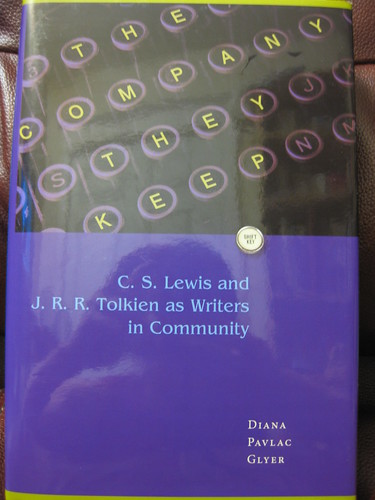
What? The Company They Keep: C. S. Lewis and J. R. R. Tolkien as Writers in Community by Diana Pavlac Glyer, Kent State University Press, 2007
Where? The Bob Miller Book Room
Why? This is my meta entry: Glyer uses the Oxford literary group known as the Inklings as a case study in writers who have worked in community. Know your subject!
***
Note I have extended the deadline this month – you have a week to enter rather than the usual three days. Good hunting!
May 25, 2009
Gaspereau Press & Quality Books
The Afterward is reporting the very distressing news that Gaspereau Press, independent printers & publishers based in Nova Scotia, is significantly reducing their staff and delaying several publications. In these tense economic times this is barely a blip on the publishing-job-cut radar – two and a half jobs eliminated, three books delayed – but for a press of Gaspereau’s size this is significant. With only about a dozen new books offered annually and a future release schedule undecided one can’t help but feel a bit grim about their future.
I adore Gaspereau Press. They are among only a few publishers left in the country who print their own books and the results are artisanal. The mission statement on their website – which I encourage you to read – describes their standards but let me add that their books have a tactile quality that is totally unique, marrying letterpress text with handmade papers and inventive presentations. Furthermore, unlike other publisher-presses like The Porcupine’s Quill, Gaspereau offers their printing services and standards to the commercial public. If you need a well-bound, professional and beautiful book printed – say, a catalogue, a journal, or a self-published work – they are one of only two Canadian (along with Coach House Books) options that I am aware of. That does not a healthy local fine press ecosystem make.
There’s not much left to be said except to implore you to visit their website and take a good look at their product, and next time you need to procure a well-crafted gift for someone, consider throwing some business their way. I would hate for this latest news to be a herald of the end.
May 21, 2009
The Smart Guy: Hero or Villain?
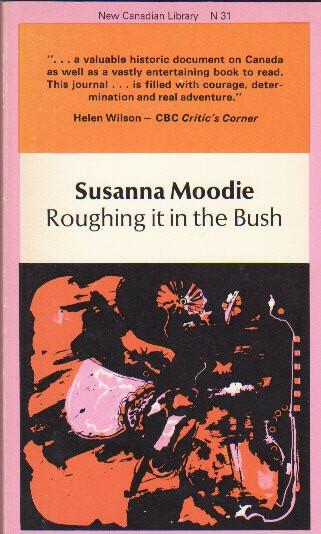 Susanna Moodie’s Roughing It In The Bush, that lonely work of early Canadian literature, has a lot to pick apart for the modern reader. While being generally well written and amusing it is hard to ignore the prejudices of its period that leap off every page. Moodie and her husband aren’t so much “roughing it” as they are “complaining about it”. In an era of cholera outbreaks, crop failures, financial ruins and social upheavals Moodie seems chiefly astounded at how hard it is to find good help in the new world, and at how often her new neighbours swear. By page 160 she finally breaks down and has to do some manual labour herself and seems shocked that there is any virtue in it. Despite professing to have come to love her adoptive country she nevertheless speaks with nothing but disdain for a good number of its inhabitants, the Loyalist Americans and the Irish especially.
Susanna Moodie’s Roughing It In The Bush, that lonely work of early Canadian literature, has a lot to pick apart for the modern reader. While being generally well written and amusing it is hard to ignore the prejudices of its period that leap off every page. Moodie and her husband aren’t so much “roughing it” as they are “complaining about it”. In an era of cholera outbreaks, crop failures, financial ruins and social upheavals Moodie seems chiefly astounded at how hard it is to find good help in the new world, and at how often her new neighbours swear. By page 160 she finally breaks down and has to do some manual labour herself and seems shocked that there is any virtue in it. Despite professing to have come to love her adoptive country she nevertheless speaks with nothing but disdain for a good number of its inhabitants, the Loyalist Americans and the Irish especially.
What surprised me, however, was that the grounds on which she repeatedly claims superiority over her neighbours was so familiar to me. Literacy, she tells her American neighbour. She, Moodie, can expect a certain reverence from her neighbours and her servants not because of her colour, wealth or nationality, but because of her education (putting aside for today the glaring fact that her education is the privilege of her colour, wealth and nationality).
It is not very fashionable today to claim superiority over another person for any reason whatsoever, let alone for reasons stemming from socioeconomic happenstance. And yet I can’t help but think that our attitudes towards the superiority of the literate person have changed only in how we voice the attitude: now the uneducated person has our sympathy and our pity, and we feel responsible for raising them up out of their ignorance. The story told by Western literature still goes that the hero, the good guy, is the guy with the book in his hand.
This narrative is especially glaring in stories about disenfranchised minorities: the poor, the brown, the unenlightened. Consider two recent, critically lauded examples: Larry Hill’s The Book of Negroes and Peter Carey’s True History of the Kelly Gang. Both books are biographies of heroes who rise beyond their difficult circumstances and score one for the little people, and in both cases the hero is set apart from their peers by their literacy. Hill’s Aminata is as well read as any educated aristocrat and it earns her every protector and defender she has in her story. Carey’s Ned Kelly, meanwhile, is literate enough to write his own history and is depicted as hauling a worn old copy of Lorna Doone through all his trials and tribulations. Reading is a great power wielded by these characters and it is the magic that gives them their break.
Of course, literacy is a great power and for that reason it is rightfully identified as one of the pillars of a strong, fair, free society. Yet when expressed by Susanna Moodie as a superiority I find myself questioning my literate person’s worship of the printed word. To what extent is this idea that literate = superior a cultural assumption made by a society which hails the (European) printing press as the pinnacle of civilization? Would we have as much respect for an illiterate hero?
How interesting also that the hero of literature is a learned one, while in real life the smart guy is still an object of distrust and ridicule. Neal Stephenson’s Anathem, in one of its more brilliant moments, has a hilarious scene in which the scientist-monks cloistered in their concent (a sort of convent – not a typo) are drilled in the many ways society has vilified and objectified the learned man in order to gain back some power from him. The learned man as wizard. The learned man as conspirator. The learned man as bearer of fire and bringer of Armageddon. We don’t even have to look to literature for precedents (in fact, we’re better off not) – I am given to understand that the President of the country next door takes an awful lot of flack on a daily basis for being smart. Hide the books and the Dijon if you want to avoid being beat up at recess.
There seems to be a disconnect between our literati and our popular culture. Susanna Moodie made no headway trying to explain to her American neighbour why her education entitled her to greater respect – the neighbour still felt she was a useless old country lady who wouldn’t survive two winters in Canada. Are our contemporary writers suffering from the same blind spot? Would Aminata Diallo have really won all those allies with her brain for books, or would she have been put down extra-hard because of the impertinence and the threat it represented? Is the bookish hero just a collective fantasy drawn up by bookish people for bookish audiences?
May 18, 2009
Happy Victoria Day!
I think Kate Beaton might agree with me that it’s time to bring some Victoria back into our Victoria days.
May 15, 2009
Always Look Twice: Two More Parables
Yesterday afternoon I got an email titled “FW: Congratulations!” Being 99% sure this was another internet lotto spam, I marked it for deletion. But something stayed my hand and I decided to give it a quick glance first. You know, just in case.
“Did you get my previous email of May 5th?” the email asked. I scanned the attached email. “Congratulations!” it read, “You have won FIRST place in the National Book Collecting Contest!”
After picking myself up off the floor I spent the next ten minutes running up and down the stairs viewing the email on two different computers just to be sure. In the meantime my much more level-headed husband opened a bottle of wine and phoned our families for me to give them the exciting news. This was the first-ever National Book Collecting Contest and the only year I would ever be eligible (next year I will be too old). To say I am thrilled beyond description would still be a gross understatement.
So in celebration of my now-prize-winning collection I thought I’d tell the story of one of my favourite books, the tacky and overlooked Easton Press edition of The Three Musketeers by Alexandre Dumas père.
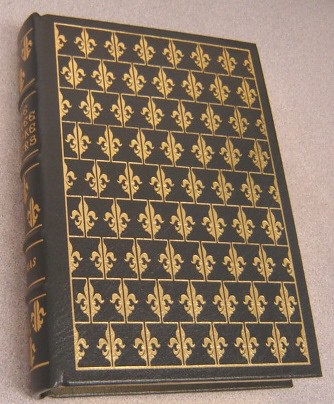
Easton Press published in the 1970s a series called “The 100 Greatest Books Ever Written”, reprints of book club editions bound in leather and pressed with gaudy gilt decoration. These are the kinds of books you might want to decorate a film set with, or maybe your show-library. I doubt very much that many people actually read them, and I certainly believe that Easton Press paid somewhere between little and no attention to picking, editing and publishing them. I recently saw another copy of the book at the Toronto Book and Paper Show and considered seriously buying it in order to have it made into a purse.
So why is this my favourite book? Because of the “portrait of the author”:
I don’t know a huge amount about much, but I do happen to know a lot about the author of the Three Musketeers and that ain’t him. In fact, I recognize the chap in that painting. It’s this guy:
Alexandre Dumas fils, the son of the author. Alexandre Dumas père, the author of The Three Musketeers, The Count of Monte Cristo and hundreds of other gems looks like this:
It’s a forgivable mistake to make. I’m sure the artist went to the library for a reference photo, found young Dumas and went to town, having no idea that there were two Dumases. But what tickles my funny-bone is that for forty years, no one noticed. Not the artist, not the editor, not the publisher, and not a single reader, seller or collector. Why? Because of the nature of the edition: it was never intended to be read by anyone who had a clue. The target audience is people who want to be spoon-fed a library of “classics” that look fancy, without having to know anything about literature themselves. The books are designed to look good on a shelf, not to be read and enjoyed.
I admit it, I have an odd sense of humour. But I love this. I just love it. What effort and expense to create a book for looking at. Without a second care for the contents!
The history of publishing is full of quirky little discoveries like this, though. It’s the whole fun of collecting: finding those things that are special, that tell a story beyond the narrative printed on the page. Thrilled as I am to have won the inaugural contest, I am almost equally thrilled that one has been established. There is a pleasure to be had here that more people – especially of my generation – could partake of. And what excellent incentive!
May 13, 2009
In Which I Feel Smug
I have re-enrolled at the University of Toronto in order to tack a major in Book and Media Studies onto my old degree. This was a controversial decision for me; after all, I am already working, blogging, tweaking a novel and trying to raise a 10-month-old. Who has time to go back to school? Well, you know what they say: you can sleep when you’re dead.
The course instructor for my summer course has made the very interesting but not unheard of decision to get us all of our assigned readings (120 pages a week worth, I’m told) in digital format. Though her primary motive was to lower our book costs, she also felt it was an appropriate (or maybe she said “topical”?) move in light of the fact that we will be spending some time studying “the death and possible rebirth of the book”. Anticipating any student complaints about having to print the readings out, she recommends to us that we purchase Adobe Acrobat Professional in order to digitally annotate our readings.
I have spoken here before about the problem of annotating digital texts. As I mentioned, I keep a stash on hand of journals in order to keep notes on texts so that I don’t have to mark up my books. So, no problem, right?
Ugh. Well it is one thing, it turns out, to camp out on my couch with a cup of tea, a book, and a journal to take notes. It’s quite another thing to be tethered to a computer. I have never in my life longed for a laptop before. I don’t want to read in front of my computer. I want to read in my sitting room, or in the garden, or at Madeline’s. And another thing? I don’t understand how anyone can read 50 pages of dry theory in a webbrowser without succumbing to the urge to pull up a tab and check Facebook. That’s a temptation I just don’t need. Good grief.
I’d like to reintrench myself as a supporter of actual, physical texts. I don’t care what it costs. This endless list of pdfs is sucking all the pleasure out of reading.
May 11, 2009
Collecting (?) Webcomics
My weekend at the Toronto Comic Arts Festival was amazing, despite being severely curtailed by my responsibilities as mother to a 10-month-old. I rushed around picking up everything I desperately wanted, but didn’t have the time to browse for undiscovered gems. Alas. But I have my trove. Once home with it I started sorting it into my library and discovered that three out of my four purchases were printed books of webcomics:

The archivist in me (and all book collectors have an archivist in them) is unapologetic. Webcomics are wonderful daily diversions but are also increasingly sophisticated and memorable media. You want to go back to it, reference it, quote it. And while you might be assured that, don’t worry, it’s hosted safely on a server somewhere, I am not. I need to be assured of a thing’s permanence. I need it at my fingertips.
One of the quirks of book collecting is how we covet the firsts – first editions, first printings, first appearances, first translations. There is an authority conferred on an “original” text which is lacking in subsequent printings. Nevertheless, in the case of literature that first appeared in another media, bibliophiles tend towards the first book version of a text. Dickens, as we all know, first published most of his novels in monthly installments – little folded blue-green wraps that were issued monthly. And while these little chapbooks are valuable (say $2,000 for all the installments of Nicholas Nickleby) they don’t compare to the first edition of the book (about $13,000 for our Nickleby in book form). The works of my dear Alexandre Dumas follow a similar pattern. Though first published in chapters through a variety of Paris newspapers and journals, collectors don’t form lines for old issues of La Presse, but will pay thousands for the Paris editions of the books (or more for the legendary Brussels editions).
Comics, on the other hand, follow an entirely different model. Comic collectors want the first form of a comic, and will even covet first “appearances” of characters in other comics, or sketches on the back of cocktail napkins if they can be shown to be the first time a character took form. Copies of old Golden Age comics will sell for tens, if not hundreds, of thousands of dollars. But the graphic novels – the book-form summaries of a storyline or series of comics – are virtually worthless to comic collectors.
As webcomics gain in mainstream popularity and cultural significance, how they will be preserved by society will become increasingly relevant. And though webcomics at the moment are lumped in with the comics crowd rather than the literature crowd, there is no way they can be collected the same way comic books can. After all, there is no original. Even if you wanted to make a case for collecting the first sketches an artist did before uploading them to her website, this doesn’t universally apply. Many webcomic artists work exclusively in a digital medium (see: the popular Toronto-based comic A Softer World, which is created by Photoshopping text onto digital photographs.)
Collectors of “strip” comic book artists (such as Bill Watterson) have pioneered this problem for us by becoming hybrid collectors. The collectible entity for a “strip” collector is collections in book form – hearkening back to the Dickens and Dumas collectors – and licensed product, as well as any original sketches they can lay hands on. Collectors of webcomics (and there will be collectors of webcomics, even if just institutions preserving them for research’s sake) have this task doubled in importance. Whereas the source material of a strip comic might always be found in newspaper archives, the source material for a webcomic could very well vanish altogether. The internet feels very big and permanent but in reality it just isn’t. Websites go down and servers crash. Redundancy helps to an extent but the authority of the material is badly damaged when a piece is no longer found housed by its creator. “Photoshopping” a comic is too easy when Photoshop was the original means of production.
Which brings us back to my purchases of webcomic anthologies. Often self-published by the creators, these anthologies are the highest permanent authority of this material. It helps, too, that some webcomic anthologies are beautifully presented, just as retrospectives of strip artists are (see the recent anthologies of The Complete Peanuts or the new Collected Doug Wright). Artist David Maliki! has even published his latest anthology with “utility space” in which to sketch and personalize inscriptions:
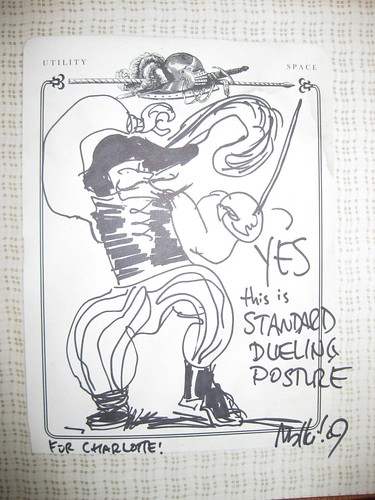
On that note, collecting anthologies of webcomics is also good fun because, unlike writers who will simply sign their inscriptions, comic artists will draw things in your book for you, which is always extra cool.
I overheard a conversation in my local comic book shop recently in which a budding comic book artist was asking the shop owner if he should publish his work in print or online, and the owner recommended “both”. The artist seemed incredulous, but I heartily agree with the assessment. Publishing online is a great way to reach an audience, and webcomics today are exploding in readership and legitimacy. But the print version is essential for posterity, and if done well, will find an appreciative and diligent archival following.
May 6, 2009
The Toronto Comic Arts Festival and Why a Book Collector Should Care
 The Toronto Comic Arts Festival is this weekend (May 9th-10th 2009), though lead-up events including Free Comic Book Day and an “Indoor Block Party” featuring Kid Koala have been scheduled to happen all this week. I hadn’t really been payng a lot of attention myself until earlier this week. On Free Comic Book Day I picked up Volume 3 of the Comics Festival sampler and finished it feeling downright inspired. I’ve always liked comic books but considered it a hobby completely unrelated to my book collecting or even literary pursuits – I don’t even list the graphic novels I read when tabulating the list of “What I Read This Year”, even though I read dozens upon dozens of them every year. Why not? I couldn’t even tell you. Possibly so I don’t have to own up in public to exactly how many of Marvel’s Ultimate [Insert Title Here] trades I own.
The Toronto Comic Arts Festival is this weekend (May 9th-10th 2009), though lead-up events including Free Comic Book Day and an “Indoor Block Party” featuring Kid Koala have been scheduled to happen all this week. I hadn’t really been payng a lot of attention myself until earlier this week. On Free Comic Book Day I picked up Volume 3 of the Comics Festival sampler and finished it feeling downright inspired. I’ve always liked comic books but considered it a hobby completely unrelated to my book collecting or even literary pursuits – I don’t even list the graphic novels I read when tabulating the list of “What I Read This Year”, even though I read dozens upon dozens of them every year. Why not? I couldn’t even tell you. Possibly so I don’t have to own up in public to exactly how many of Marvel’s Ultimate [Insert Title Here] trades I own.
But the feeling I got after visiting the Beguiling this weekend is that anyone living in Toronto today who has any interest in book history, book collecting or literary movements at all would be absolutely foolish not to open their eyes and take a look at what is happening in comics here. The book media has been touching on it in pieces and bits for a few years now. “Graphic novels” are becoming part of the literary mainstream, beginning with Art Speigelman’s Pulitzer for Maus and continuing today with landmarks like Mariko Tamaki (and Jillian Tamaki)’s Governor General nomination for Skim and the New York Times‘ new Graphic Books Best Seller List. The school system has figured out that adding graphic novels and manga to their libraries will actually get kids to read and independent, “adult” comic book artists are getting exposure as far ranging as political covers for the New Yorker. Graphic novels are increasingly accepted as a legitimate literary form and Toronto is, right now, one of the most vibrant, innovative and productive comic-producing cities out there.
If you were a book collector in London in 1917 you would probably have been aware of the Bloomsbury Group and, if you were paying any attention, you would have been taking full advantage of being at the very heart of something new. You’d have had your pick of new publications, shows, newspaper clippings and sightings as Modernism sprouted its wings and took off. You might have decided, no, there was still surer money in Dickens and Trollope. But for someone looking to get in on the ground floor of something that might (and did) become the new literary standard, Bloomsbury was the place to be and to collect.
Now, I don’t mean to imply that the Toronto comic scene today is the new Bloomsbury. But you can’t deny that smell of fresh ideas, new blood and being on the vanguard of something which, in thirty years, might be a huge influential part of the literati mainstream.
To list of Toronto who’s who in the comic world exceeds my space allotment here. Take a look at the TCAF guests. Suffice to say in the four years that have passed between the 2005 Comics Festival (featuring Seth, Chester Brown, Bryan Lee O’Malley, Chip Zdarsky, Kean Soo, Kagan McLeod and more) and the 2009 edition, the quality of work and the number of artists has, in my opinion, jumped exponentially. Further, the best artists in town are producing some of their best work right now. And, maybe best of all, few of them have had the leisure to quit their day jobs and so getting inscriptions, sketches and other collectible ephemera is dead easy.
Comic book collecting is nothing new, but the evolution of the genre right now is bringing the pursuit into book collecting turf. The two activities have been separate so far: the expertise needed for one doesn’t help much with the other, and I can’t speak for other book collectors but I have never found the idea of owning a floppy, shrink-wrapped comic very attractive. Graphic novels are, on the other hand, an entirely different matter. These are books. Bindings, book design, editions and bibliography is starting to become relevant. Libraries and scholars need the materials. Many more artists are working in a straight-to-graphic novel format rather than the old model of episodic issues followed by a graphic novel compilation.
Ten years ago might have been the best time to start a Toronto-based graphic novel collection, but the window is not closed. It seems as if people are getting their big breaks daily in this city. After seeing the samples of some of the new work coming out of the city, you can bet your bottom dollar I am going to get my butt out to the Toronto Reference Library this weekend and see what’s on offer. I don’t want to be the one wishing I’d taken a chance twenty years from now when this is retrospectively viewed as the golden age of a budding genre. Worst case scenario, I own some amazing works by local, emerging artists. What’s to lose?
